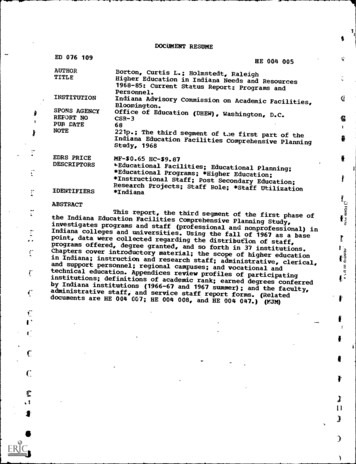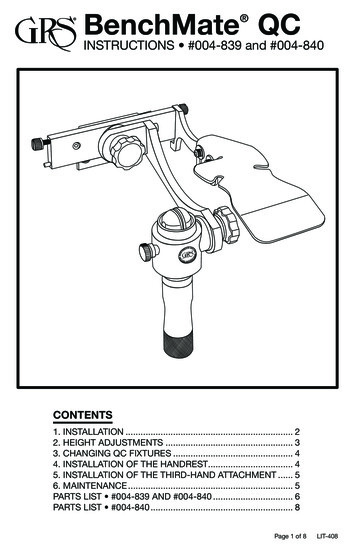
Transcription
DOCUMENT RESUMEED 076 109AUTHORTITLEINSTITUTIONSPONS AGENCYREPORT NOPUB DATENOTEEDRS PRICEDESCRIPTORSIDENTIFIERSHE 004 005Borton, Curtis L.; Holmstedt, RaleighHigher Education in Indiana Needs and Resources1968-85: Current Status Report: Programs andPersonnel.Indiana Advisory Commission on Academic Facilities,Bloomington.Office of Education (DHEW), Washington, D.C.CSR-368221p.; The third segment of tae first part of theIndiana Education Facilities Comprehensive PlanningStudy, 1968IMF- 0.65 HC- 9.87*Educational Facilities; Educational Planning;*Educational Programs; *Higher Education;*Instructional Staff; Post Secondary Education;Research Projects; Staff Role; *Staff Utilization*IndianaIIABSTRACTThis report, the third segment of the first phase ofthe Indiana Education Facilities ComprehensivePlanning Study,investigates programs and staff (professional andIndiana colleges and universities. Using the fall nonprofessional) inof 1967 as a basepoint, data were collected regarding the distributionof staff,Programs offered, degree granted, and so forth in 37institutions.Chapters cover introductory material; the scope of highereducationin Indiana; instruction and research staff;administrative,clerical,and support personnel; regional campuses; andvocational andtechnical education. Appendices review profilesof participatinginstitutions; definitions of academic rank; earned degrees conferredby Indiana institutions (1966-67 and 1967 summer);and the faculty,administrative staff, and service staff report forms. (Relateddocuments are HE 004 007; HE 004 008, and HE 004 047.) mpg0tfVW'ttJII
Higher Education in IndianaNeeds and Resources 1968-1985Current Status ReportIndiana Advisory Commission on Academic FacilitiesU.S. DEPARTMENT OF HEALTH.EDUCATION & WELFAREOFFICE OF EDUCATIONTHIS DOCUMENT HAS BEEN REPRO.DUCED EXACTLY AS RECEIVED FROMTHE PERSON ORORGANIZATION ORIG.MATING IT POINTS OF VIEW OR OPIN.IONS STATED DO NOTNECESSARILYREPRESENT OFFICIAL OFFICE OF EOUCATION POSITION OR POLICYFILMED FROM BEST AVAILABLE COPY
INDIANA CONFERENCE ON HIGHER EDUCATIONNeeds and Res ;times Committee, 1967-68LANDRUM BOLLING, ChairmanPresident, Earlham CollegeCHARLES BANET, President,St. Joseph's CollegeISAAC K. BECKES, President,Vincennes UniversityJOHN EMENS, President,Ball State UniversityLYN') Esc's, President,Indiana Central CollegeFREDRIC M. HADLEY. President,Indiana VDeational Technical CollegeFRED HOVE, President,Purdue University0. P. KRETZMANN, President,Valparaiso UniversityALAN C. RANKIN, President,Indiana State UniversityROBERT REsaoos, President,Anderson CollegeELVIS STAHR, President,Indiana UniversityINDIANA ADVISORY COMMISSION ON ACADEMIC FACILITIESIndiana University. Bloomington, IndiansR. E. MASTERS, Executive SecretaryHERMAN SI WELLS, ChairmanBloomingtonA. F. SCRIBNER, SecretaryValparaisoJAMES D. ACHERFranklinWILLIAM A. BRENNANIndianapolisALAN BRENTANOElm.17411eGEORGE S. DIENERIndianapolisJAMES EDGETTFort WayneFLOYD HINESConnersvilleMits. RICHARD INSKEEPFort WayneJ. KURT MAHRDTIndianapolisBORDEN PURCELLIndianapolisGLENN W. SAMPLEIndianapolisMRS. GEORGE N. SHUSTERSouth BendRICHARD B. STONERColumbusJ. RALPH TRoatesoxSeymourMAN WRICHTBeech GroveINDIANA HIGHER EDUCATION FACILITIESCOMPREHENSIVE PLANNING STUDY1967-68 Study StaffCHARLES F. BOKSER, Study DirectorJAMES F. BLAKESLEY, Associate DirectorSpace StudiesContributing AuthorsPAUL C. BAYLESSCURTIS L. BORTONM. M. CHAMBERSRALEIGH HOLMSTEDTHARRY LINCOLN KEITHPATRICIA L. NAGELNELSON PARKHURSTW. CHARLES SHERWOODMRS. BETTY SUDDARTHFREDERICK H. WOLFResearch AssistantsNANCY BEELER, WILLIAM S. DUNN, CHARLES B. HATCHER, JAMES LORD,JAMES R. MARSHALL, C. MICHAEL MATTHEWS, GEORGE E. MORGAN,BRUCE PETERS, GREGORY L. SOLOMON, ROSANISI SPIRO, BARI;.RA C. THATCHERTypistsMARY ALICE COLE, JEANNE JOPES, MARSHA RINALDIELIZABETH S. SNIVELS', Copy Editor1
HIGHER EDUCATION IN INDIANANEEDS AND RESOURCES 1968-85CURRENT STATUS REPORT:PROGRAMS AND PERSONNELbyCurtis L. BortonResearch Analyst, Indiana UniversityandRaleigh HolmstedtPresident Emeritus, Indiana State UniversityPrepared forTHE INDIANA ADVISORY COMMISSION ON ACADEMIC FACILITIESin Cooperation withTHE INDIANA CONFERENCE ON HIGHER EDUCATION1968-
FOREWORDThis report represents one segment of the first phase of the IndianaHigher Education Facilities Comprehensive Planning Study thatwas begunin the summer of 1967 under the sponsorship of the Indiana AdvisoryCommission on Academic Facilities.Funds for the project were madeavailable to the commission by the U.S. Office of Educationunder theHigher Education Facilities Act of 1963 (P.L. 88-204).Cooperating inthe study with the advisory commission is the Indiana ConferenceonHigher Education, a voluntary organization of thirty-eight Indianacolleges and universities.The Needs and Resources Committee of theIndiana Conference worked with the study director in developing the scopeand outline of the study.This study has two primary objectives.First, we hope to developa detailed look at the future needs and expected resources of the institutionsof higher education in Indiana and the likely impact ofvarious alternativepolicy actions.We will attempt to present this information in a formthat will be useful in the planning processes of theIndiana Conferenceon Higher Education, the Advisory Commission on Academic Facilities, theU.S. Office of Education, and the Indiana General Assembly.Secondly,we have designed the study to facilitate its utilization by theindividualinstitutions of higher learning in the state.Although the publishedreports from the project will deal only with groups of- institutions orstatewide totals, we will also supply each institution cooperatinginthe study with detailed confidential information about itsown institution.This has already been done in the areas of enrollmentprojections and
iifacilities inventory-space utilization analysis, and the approachwillbe continued in the remaining phases of the study.These data will alloweach institution to see how it compares wit% the statewidefindings an-1should also further its data base development and planningefforts.The general research design of the over-all study is presentedinan outline-flow chart form.During this first year of the study,thefocus has been mainly on the development of a comprehensivesurvey of thecurrent scale and composition of higher education in Indiana.This phis(is culminated with the publication of six "current status"reports.are based on surveys conducted duringThesethe 1967-68 academic year and coverfacilities inventory-space utilization, programs and faculty andstaff-,finances, student migration patterns, and preliminary projections ofstudent enrollments.The sixth report summarizes the findings and impli-cations of the surveys.The second year of the study will be devoted to the long-run forecastof needs and resources.Special studies will be conducted of future spaceneeds, the Composition of the future demand fOr highereducation, futurefaculty and staff needs, and expected revenues.In addition, a simulationmodel of Indiana higher education will be constructed that will allowus totest the impact of alternative assumptions about future growthpatternsin higher education in the state.For instance, we'will be able to assessthe needs and resources effects of such factorsas alternative facultysalary assumptions, changes in the demand for varioustypes of academicprograms, and alternative allocationspublic institutions.of enrollments between private and
iiiOur study obviously could not be successful without the fullestcooperation of the institutions involved.has been superb would be an understatement.To say that this cooperationThe schools committed them-selves to the project in the summer of 1967 and held to that commitment.throughout the year.They not only allowed the study staff access to theirrecords, but they also assumed the responsibility of developing much ofthe raw data.We know this was a particular imposition on their limitedtime and staff resources in many cases, and we can only hope that theirefforts will prove beneficial to the long-run development of highereducation in the state.Finally, a special word of thanks is in order to the Graduate Schoolof Business and the Bureau of Business Research at Indiana University.Although the study is not an official Bureau project, the School ofBusiness has released part of my time to serve as st,Idy director forthe project, and the study has been housed in and received the supportof the Bureau of Business Research.Without the advice and assistance ofthe Bureau staff, logistical and research support problems would havebeen much more difficult.Charles F. BonserStudy DirectorAssociate Director, Bureau of Business ResearchGraduate School of BusinessIndiana University
1467Programs-FacultySurveyFinancial SurveyJanFacilitiesSpace Utilisation StudyEnrollment StudiesPrelim. Projections& MigrationJulyReports-SpaceIndividual ?Legs. .LUtilization-4LReportI"The Current Situation"I/JulyModel ConstructionForeacsting-SimulationCost StudiesForecast ofNeeds for faculty& StaffRegional DemandStudyProgram DemandStudiesPreliminary Forecastof Space NeedsFinancing Studies& ForecastJan.costsForecast ofForecast ofOperatingCosts11,--Costs, Enrollments!s PoliciesIlmpact of alter- 1czative Programs.1;Expected FinanciaNeeds & Resourcesto 1985Final ReportSummary &ConclusionINDIANA HIGHER EDUCATION FACILITIES STUDYPROPOSED WRE SCHEDULEJuly
VPREFACEThis study, undertaken by the Indiana Advisory Commission on AcademicFacilities, investigates programs'and staff (professional and nonprofessional)inIndiana colleges and universities.Using the fall of 1967 as a base point, datawere collected regarding the distribution of staff, programs offered, degreesgranted, and so forth in 37 institutions.The findings of this study should bemeaningful to all concerned with the future development of Indiana colleges anduniversities during the present decade and beyond.This study was made possible through the cooperation of the following institutions.We are indebted to the administrators of these institutions whoaided in the collection of the data.Anderson CollegeBall State UniversityBethel CollegeButler University'Christian Theological SeminaryDePauw UniversityEarlham CollegeFort Wayna Bible CollegeFranklin College of IndianaGoshen CollegeGrace Theological Seminary andGrace CollegeHanover CollegeHerron School of ArtIndiana Central CollegeIndiana Institute of TechnologyIndiana State UniversityIndiana UniversityManchester CollegeMarian CollegeMarion CollegeOakland City CollegePurdue UniversityRose Polytechnic InstituteSt. Benedict CollegeSt. Francis CollegeSt. Joseph's CollegeSt. Joseph's College at CalumetSt. Mary-of-the-Woods CollegeSt. Mary's CollegeSt. Meinrad SeminaryTaylor UniversityTri-State CollegeUniversity of EvansvilleUniversity of Notre DameValparaiso UniversityVincennes UniversityWabash CollegeDuring the early preparation of the study, Barbara Thatcher assisted Dr.Raleigh Holmstedt, President Emeritis of Indiana State University, in the development of data gathering instruments and in establishing communications with theparticipating institutions.
VIHIGHLIGHTSSCOPE OP HIGHER EDFCAlloNfhirly-one of the 37 institutions of higher learning areaccr(ditcd bythe North Central Association of Colleges and Secondary Schools.Of the 164,697 students enrolled in the participating institutions inthe fall of 1967, 76.0 percent were undergraduate students; 18.5 percentwere graduate students; and 5.5 percent were in "other" (noncredit, adulteducation) programs.rota( enrollments increased 104 Nrcent over the 1957-67 period, withnearly four-fifths of the enrollment increase occurring in the publicinstitutions.rhe most rapid growth in enrollment occurred in the graduate cnrollmcnt(an increase of 181 percent.).A total of 25,434 degrocA were awarded by the 37 participating instiltainns from September, 1966, to September, 1967, with the largestnumber of degrees on all levels .being awarded in the field of education.The Indiana increase in earned degrees from 1954-55 to-1964-6.5 wasgreater at all degree levels than that of the United States as a whole, especially on the master's level.(Indiana grants 3.3 percent of the totalearned degrees in the United States.)The Indiana Conference on Higher Education, formed in 1944 to resolveimpending postwar problems, has been the only body representing the totalsystem of higher education in Indiana and has fostered a variety of programsof institutional cooperation.FACULTY AND RESEARCH srAITThe 37 participating institutions reported a total of 13,567 faculty
VIImembers (7,119 full-time and 6,448 part-time) engaged in the 44 fields ofinstruction and research.The largest number of faculty members was employed in the science field,with physical and biological sciences having 15 percent of the total.The public institutions utilized 64.5 percent of the faculty resources,and the private institutions employed 35.5 percent.Almost one-half (48.0 percent) of the full-time faculty members hold thedoctor's degree; 36.9 percent hold the master's degree; 4.1 percent have thefirst professional degree; and 11.1 percent hold the bachelor's degree.Less than one-fifth of the total faculty are womenThe loss of faculty in 1967 (about 11 percent) was approximately equalin public and private institutions.About 18 percent of the faculty in thefall of 1967 were new to their respective institutions.The increase in thenumber employed from 1966 to 1967 was 7.3 percent in the private institutionsand 8.2 percent for the public institutions.Faculty salaries varied over a wide range--on a 9-month basis the lowestinstitutional average was 6,200, and the highest average was 12,430.Theaverage salary (9-month basis) for the total faculty of the 33 reporting institutions was 10,826.Faculty salaries in the Indiana institutions are just about equal to theaverage of comparable institutions in the United States.The average expenditure for fringe benefits was 1,703 per faculty member.The ratio of faculty to students varies from 1:8.0average of 1:13.1.to 1:29.1, with anPrivate institutions have higher student-faculty ratiosthan the public universities, but there is no relationship between thisfactor and size of institution.
ADMINISTRATIVE, CLERICAL, AND SUPPORV PERS0NNELThe 37 institutions employed a full-time equivalent of 4,064.9 professionaladministrators.Almost 70 percent of the adminibtralors were in academicadministration, business administration, and student personnel administratien.Te.largest single -group of professionaladministrators vensisted ofstudent: personnel' administrators in the private institutions and academicadministrators in the public institutions.Secretaries and stenographers(full-time equivalent of 2,420.64) make upmore than 0 percent of the total number of clerical personnel (full-timeequivalent of 4,269.12).iqmost half or the support personnel performed maintenance andjanitorial functions.rhe total number of all library personnel for the 37 reporting institutions was 795.REGIONAL CAMPUSESOrganized programs in higher education arc operated by Indiana StateUniversity, Indiana University, and Purdue University at 10 regional campuseslocated in 9 major metropolitan communities.Between 1957 and 1967 enrollments at the regional campuses increased172 percent (a higher rate than that of the home campuses) and reacheda totalof 27,767.Administrative staffs at the regional campuses total 165.4 full-Limeequivalent administrators; faculties consist of a full-time equivalent of1,047.2,; clerical staff totals a full-Lime equivalentof 297.1; and serviceand suppor' staff amounts 10 a full-lime equivalent of 221.6.
IXVOCATIONAL AND TECHNICAL EDUCATLONBetween September, 1966, and September, 1967, 51,190 persons were enrollee. programs of vocational and technical education.Vocational training is provided by: (1) adult evening programs (sponsoredby the Division of Vocational Education of the State Department ofPublicInstructionand the Manpower Development Act); (2) college and universityprograms; (3) public agency programs (city hospitals offer health careerprograms)(4) Indiana Vocational and Technical College programs; and (5)private training institution programs (barber colleges, businessmachinctraining schools).
xTABLE OF CONTENTSForewardPrefaceHighlightsviList of Tables,xiChapter 1IntroductionChapter IiThe Scope of Higher Education in IndianaChapter IIIInstruction and Research Staff41Chapter LVAdministrative, Clerical, and Support Personnel80Chapter VRegional Campuses108Chapter VIVocational and Technical Education113Appendix AProfiles of Participating Institutions129Appendix BDefinitions of Academic Rank194Appendix CEarned Degrees Conferred by Indiana Institutions(1966-67 and 1967-Summer)-. .194Appendix DForm F (Faculty Report)203Appendix EForm A (Administrative Staff Report)204Appendix FForm S (Service Staff Report)20516
XLIILIST OF TABLESTablePage1Indiana Institutions of Higher Education, 1967-682Accreditation of Indiana Institutions of HigherEducation by the North Central Association of Collegesand Secondary Schools, 196732Professional Accreditation of Indiana Institutions ofHigher Education333.324Enrollments in Participating Institutions, Fall, 19675Comparisons of Enrollments of Public and Private Institutions, Fall, 196735Comparison of 1957 and 1967 Enrollments of Participating Institutions36Earned Degrees Conferred by Participating Institutions(1966-67 and 1967 Summer)37Bachelor's and Four-Year First Professional DegreesAwarded in Professional Fields, 1966-6738Earned Degrees, United States and Indiana39Distribution of Earned Degrees by Field, United Statesand Indiana, 1966-6740Distribution of Full-time Equivalent Faculty by Rankand by Field of Instruction and Research in IndianaHigher Education, Fall, 196757Distribution of Full-time Equivalent Faculty by Fieldand Type and Size of Institution, Fall, 196759Number of Faculty Employed in Summer Sessions of IndianaInstitutions of Higher Education, 196761Distribution of Faculty by Academic Degrees and Typeand Size of Institution, Fall, 196762Distribution of Faculty Members by Academic Rank and.by Highest Degree Level, All Participating Institutions,Fall, 196763Distribution of Faculty Members by Academic Rank and byHighest Degree Level, All Public Institutions, Fall,19676468910111213141516.34
X ILLIST OF TABLES- ttion of Faculty Members by Academic Rankand Highest Degree Level, All Private Institutions,Fall, 196765Sex of Faculty Members by Rank and Type of Institution.66Number of Full-tine Faculty Members According to Rank,Sex, and Highest Educational Level in Thirty-sevenInstitutions of Higher Education in Indiana, Fall, 1967.67Retention and Replacement of Full-time Faculty inThirty-seven Indiana Institutions of Higher Educationfor Fall Term, 196768Retention and Replacement of Full-time Faculty inThirty-two Private Indiana Institutions of Higher Education for the Fall Term, 196769Retention and Replacement of Full-time Faculty in FivePublic Indiana Institutions of Higher Education for theFall Term, 196770Number of Faculty within Each Salary Interval at Publicand Private Institutions of Higher Education, 9-10Months Appointments, Fall, 196771Number of Faculty within Each "Salary Interval at Publicand Private Institutions of Higher Education, 11-12Months Appointments, Fall, , 1967.;.Salary Averages by Rank of Full-time Faculty, 9-MonthsBasis, Indiana Institutions of Higher Education75Salary Averages by Rank of Full-time Faculty on a9-Months Basis in 5 Universities and 26 Private Colleges.Average Salaries by Rank of Indiana Institutions ofHigher Education Compared with State Universities andChurch-Related Colleges of the United States, 1967(9-10 Months Basis)Averige Salaries by Rank. of Full-time Faculty on a9-Months Basis in Higher Education (1955, 1960, 1967)737677.77
.XIIILIST OF TABLES (Cont.)Table29Paw.Average Total Expenditures of Indiana Institutionsfor Fringe Benefit Programs for Full-time Faculty,1966-677830Faculty-Student Ratios by Type and Size of Institution7931Distribution of Administrative Staff by Kind of Institution in Indiana, Fall, 196786Distribution of Part-time Administrators by Other Parttime Assignments, Fall, 196794Distribution of Clerical Personnel by Functional Areasand-Tinds of Institutions, Fall, 196796323334Support Personnel in Indiana Institutions of HigherEducation, by Kind of Institution; Fall, 1967100Full and Part-time Peofessional Library Administratorsin Indiana Higher Education, Fall, 1967103Salaries of Full-time Library Staff in Indiana Institutions of Higher Education, Fall, 1967104Salaries of Full-time Contributed Service Library Personnel in 6 Indiana institutions of Higher Education,Fall, 1967107Faculty and Staff Resources, University Regional Campuses, Fall Semester, 196711239Vocational Education Enrollment, 1966-6712540Enrollment of MDTA Programs by Locations and Occupations(May, 1967)12641Enrollment in Public Agency Programs12742Enrollment in Private Training Institutions35363738128
1.INTRODUCTIONPURPOSE AND SCOPE OF THE STUDYThe physical facilities requireiw nts for higher education aro determinedbasically fly: (1) Lhe number and type of students to be educated; (2) the na-Lure and variety of the instructional, research, and service programs provided-by the institutions, and (3) the administrative, faculty, and servicepersonnel required to operate the institutions and conduct the programs.This report will be concerned with the higher educational programs offeredby the 37 participating Indiana institutions of higher education and thestaffs employed by those institutions as of September, 1967.The analysisand summaries of the data on programs and staff are designed to show thestatus of these elements of higher education in the academic year 1967-68.The scope and adequacy of higher educational opportunities provided inIndiana are indicated by the number, type,-and size of Lhe colleges anduniversities located in the state, the fields of study in which instructionis offered and degrees granted, and the research and service programs thatthe institutions conduct.degrees.There are 43 institutions in Indiana that granLIn addition, there are 12 regional-campuses in which two or moreyears of undergraduate instruction is offered:7 operated by IndianaUniversity; 4 operated by Purdue University; and 1 operated by Indiana StateUniversity.Graduate instruction is offered by 21 institutions, at all ofthe regional campuses, and at approximately 30 extension centers scatteredover the state.The colleges and universities together with the regional campuses arewell distributed over, the staLe.Over 90 percent of the high school graduatesof Indiana live within 25 miles of an institution or a regional campus that
-2-offers two or more years of college work.In terms of the number anddistribution of institutions, Indiana is well supplied with higher educationfacilities.One purposeof this study will be to provide a basis for deter,mining the additional facilities and resources that will be necessary tomeet future needs for higher education in the state.The adequacy of the higher educational opportunities available to thepeople of the state is indicated by the academic and professional fieldsin which programs of study and preparation are offered and the quality ofthose programs.While the individual institutions vary greatly in scopL1and quality, the colleges and universities of Indiana do offer programs inall of the major academic aid professional fields.The tremendous expansionof knowledge and the applictions thereof to the increasingly complex problemsand needs of contemporary society will require a continuous revision andexpansion of the programs of higher education.Not only will more peoplehave to be educated, but more and better education will have to be provided.These factors will require additional faciLities: new types of structuresand equipment, large increases in operating funds, and corresponding inereesein personnel to operate the institutions and conduct their programs.The discovery of new knowledge is an important responsibility of highereducation.In recent years there has been a great expansion of organizedresearch supported by funds from governmental agencies, foundations, andbusiness and industry.Not all institutions participate in organized sponsoredresearch;yet, the number is increasing, and it is reasonable to expect that thistrend will continue.Research requires specialized facilities and utilizeslarge amounts of faculty and staff time.The continuation of current trendsin the expansion of research will, be an increasingly important factor indetermining future needs for facilities and staff.
-3-An extensive variety of services to governmental agencies, schoolsystems and educational institutions, business and industry, and socialagencies are provided by Indiana colleges and universities.These servicesinvolVo the applicati on of knowledge and expertise to current political,social, and economic problems.In many cases original research is required,In addition, the universities are involved in a number of projects in foreigncountries.These services require facilities, staff, and resources inaddition to the requirements of the basic instructional and research functionsof the inst-iLutions.It is reasonable to expect that the demands for thesetypes of service will continue to expand and will be significant factorsin the requirements for new facilities and resources in the future.Personnel is the most important resource of institutions of highereducation, and personnel service is the largest item of institutional-expense.The adequacy and quality of personnel are the major determinantsof strength in an institution's program of educational,services, and theutilization of personnel is the primary factor in efficiency and economy ofoperation.In projecting the future needs of higher education in Indiana,the number and type of personnel needed to staff the programs of the variousinstitutions are basic to the estimates of physical facilities and financialresources that will be required.The purpose of the faculty and staff study isto obtain complete and accurate information on all types of personnel employedin the various institutions included in the Indiana Higher. Education FacilitiesComprehensive,Planning Study.SOURCES AND LIMITATIONS OF DATAThe sources of informatiori-and data utilized in the study are listedbelow:
-41.2.3.4.5.6.7.CatalOgs of the institutions included in the studyThe Higher Education General Information Survey of the U. S. Officeof Education for 1967A report of the number and type of degrees granted by each institution in the year 1966-67 obtained from the registrarsThe "Faculty Report" submitted for each department of an institutionshowing the number and ranks of the faculty employed in the fall termof 1967The "AdministratiVe Staff Report" showing the number and titles ofadministrative officers in each institutionThe "Service Staff Report" showing the number and types of serviceand support personnel employed in all departments and service unitsof the institutionsThe "Class Organization and Staff Summary" that provides data onstudent enrollments in all classes taught in the institution in thefall term of 1967 and the "Departmental Reports" that show thenumber of classes taught, the student enrollment in each class, thestudent contact hours, and the staff contact hours for each department.These reports were obtained as part, of the facilities utilization study conducted at Purduv University.Data from these sources will give the following information concerning thescope of educational opportunities provided by each institution:1.2.3.4.5.The fields of study in which instruction is offered by each institutionThe number and types of degrees granted in each academic fieldThe number of different courses at each level of instructionoffered in each academic departmentThe student enrollment, student credit hours and student contacthours for each departmentThe number and ranks of faculty assigned to each department.These data are basically quantitative.No attempt is made to evaluatethe quality of the programs offered by each institution except when thequality may be indicated indirectly by comparisons in the quantitative data.In general, the analysis will be made for the institutions as a group withindividual institutions not specifically identified.The object is to givean overall picture of the status and scope of higher education in the state.Because of the large numbers of staff personnel involved and thedifficulties of obtaining the data, information on individual staff memberswas not obtained.This, however, is not a serious limitation as far as thepurpose of the study is concerned.The objective is to obtain bases for
-5-determining the future facilities and building needs of the higher educationinstitutions of the state.For this purpose gross numbers of the varioustypes of staff personnel required to operate the institution and its pi-ogramsare sufficient.In projecting future needs, the adequacy of institutionalstaffs will be taken into account insofar as this factor is indicated by thestaff and program data.r
-6-II.THE SCOPE OF HIGHER EDUCATION IN INDIANADuring the first months of the study, informationwas obtained foreach participating institution concerning generaland professionalaccreditation, enrollment, and degree production.Information was also--gathered about interinstitutional programs andvocational education.Thitchapter presents descriptions of higher educationprograms offered byIndiana institutions and indicates the scope, character,and content ofIndiana higher education in general.Profiles of the participating institutions-describing-the general characteristics and educationalprogramof
Taylor University Herron School of Art Tri-State College Indiana Central College University of Evansville Indiana Institute of Technology University of Notre Dame Indiana State University Valparaiso University Indiana University Vincennes University Manchester College Wabash College. During the early preparation of the study, Barbara Thatcher .











